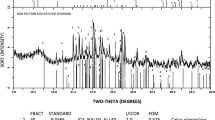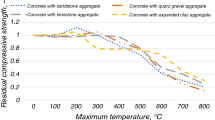Abstract
In this paper, the mechanical and long-term durability behaviour of structural lightweight concrete (LWC) produced with natural lightweight scoria aggregate (LWSA) from the Azores is analysed. Among the properties studied are the compressive and tensile strength, modulus of elasticity, shrinkage, capillary absorption, carbonation and chloride resistance. To this end, a comprehensive experimental study was carried out on different concrete compositions involving common and high-performance structural concrete produced with coarse or coarse and fine volcanic scoria aggregate. Generally, all the mechanical properties worsened with the incorporation of LWSA. It is concluded that the most efficient LWC with LWSA can attain compressive strength up to about 35 MPa. On the other hand, the production of LWC of more than 50 MPa implies a marked reduction in compressive strength for a small reduction in density. The long-term shrinkage increased with the replacement of normal-weight aggregate by LWA and was higher when coarse and fine scoria were used. However, the early age shrinkage can be counterbalanced by the internal curing effect provided by LWSA. The capillary absorption, chloride and carbonation resistance were affected by the high porosity of LWSA. The absence of the outer shell in scoria aggregate and the surface effects during tests can partly explain the lower performance of the LWC. Nevertheless, it is shown that LWC with scoria can be durable, and even for low- to moderate-strength LWC the corrosion induced by carbonation may not be relevant.
Similar content being viewed by others
Abbreviations
- LWA:
-
Lightweight aggregates
- LWSA:
-
Lightweight scoria aggregate
- LWC:
-
Lightweight concrete
- NA:
-
Normal-weight aggregates
- NWC:
-
Normal-weight concrete
- LWCSC:
-
Lightweight concrete produced with coarse scoria aggregate and natural sand
- LWCFSC:
-
Lightweight concrete produced with coarse and fine scoria aggregates
- CG:
-
Coarse gravel
- FG:
-
Fine gravel
- CS:
-
Coarse natural sand
- FS:
-
Fine natural sand
- CBA:
-
Coarse bagacina aggregate
- FBA:
-
Fine bagacina aggregate
- f L :
-
Limit strength
- f cs :
-
Ceiling strength
References
Chandra S., Berntsson L.: Lightweight Aggregate Concrete. Science, Technology and Applications. Noyes Publications–Wiliam Andrew Publishing, USA (2003)
Holm, T.A.; Bremner, T.W.: State-of-the-art report on high-strength, high-durability structural low-density concrete for applications in severe marine environments. In: Us Army Corps of Engineers. Structural Laboratory, ERDC/SL TR-00-3 (2000)
Bogas, J.A.: Characterization of structural lightweight expanded clay aggregate concrete (in Portuguese). Ph.D. Thesis in Civil Engineering. Technical University of Lisbon, Instituto Superior Técnico, Lisbon (2011)
Newman, J.B.: Properties of structural lightweight aggregate concrete. In: Clarke, J.L. (eds.) Structural Lightweight Aggregate Concrete, pp. 19–44. Chapman and Hall (1993)
Chen, H-J.; Yen, T.; Lai, T.-P.: A new proportion method of light-weight aggregate concrete based on dividing strenght. In: Holand, et al. (eds.) International Symposium on Structural Lightweight Aggregate Concrete, pp. 463–471. Sandefjord, Norway, 20–24 June (1995)
Bogas J.A., Gomes A.: Compressive behavior and failure modes of structural lightweight aggregate concrete—characterization and strength prediction. Mater. Des. 46, 832–41 (2013)
Yasar E., Atis C., Kiliç A., Gulsen H.: Strenght properties of lightweight concrete made with basaltic pumice and fly ash. Mater. Lett. 57, 2267–2270 (2003)
Hossain K.: Blended cement and lightweight concrete using scoria: mix design, strength, durability and heat insulation characteristics. Int. J. Phys. Sci. 1(1), 5–16 (2006)
Kiliç A., Atis C., Teymen A., Karahan O., Ari K.: The effects of scoria and pumice aggregates on the strengths and unit weights of lightweight concrete. Sci. Res. Essay 4(10), 961–965 (2009)
Videla C., López M.: Effect of lightweight aggregate intrinsic strength on LWC compressive strength and modulus of elasticity. Mater. Const. 52(265), 23–37 (2002)
Hossain, K.; Ahmed, S.; Lachemi, M.: Lightweight concrete incorporating pumice based blended cement and aggregate: mechanical and durability characteristics. Constr. Build. Mater. 25, 1186–1195 (2010)
Smadi, M.; Migdady, E.: Properties of high strength tuff lightweight aggregate concrete. Cem. Concr. Compos. 13(2), 129–135 (1991)
ACI318: Building Code Requirements for Structural Concrete. American Concrete Institute, Farmington Hills (2009)
Bogas J.A., Nogueira R.: Tensile strength of structural expanded clay lightweight concrete subjected to different curing conditions. KSCE J. Civil Eng. 18(6), 1780–1791 (2014)
Zhang M.-H., Li L., Paramasivam P.: Shrinkage of high-strength lightweight aggregate concrete exposed to dry environment. ACI Mater. J. 102(10), 86–92 (2005)
Hossain K.M.A., Lachemi M.: Mixture design, strength, durability, and fire resistance of lightweight pumice concrete. ACI Mater. J. 104(5), 449–457 (2007)
Lura P., Bisschop J.: On the origin of eigenstresses in lightweight aggregate concrete. Cem. Concr. Compos. 26(5), 445–452 (2004)
Mourin, D.; Vaquier, A.: Etude des états-limites des bétons dárgile expanse en compression biaxiale et de leur évolution en function de la vitesse de montée en charge. In: Arnould, M.; M.Virlogeux, M. (eds.) Granulats et betons legers-Bilan de dix ans de recherches, pp. 349–358. Presses de l’école nationale des ponts et chaussées (1986)
Zhutovsky S., Kovler K., Bentur A.: Influence of cement paste matrix properties on the autogenous curing of high-performance concrete. Cem. Concr. Compos. 26(5), 499–507 (2004)
Parhizkar T., Najimi M., Pourkhorshidi R.: Application of pumice aggregate in structural lightweight concrete. Asian J. Civ. Eng. 13(1), 43–54 (2011)
Assas M.: Transport and mechanical properties of silica fume lightweight aggregate concrete. Life Sci. J. 9(1), 628–635 (2012)
EuroLightConR18: Durability of LWAC made with natural lightweight aggregates. European Union–Brite EuRam III, BE96-3942/R18 (2000)
Bogas, J.A.; Gomes, M.G.; Real, S.: Capillary absorption of structural lightweight aggregate concrete. Mater. Struct. (2014). doi:10.1617/s11527-014-0364-x
Günduz L., Uğur I: The effects of different fine and coarse pumice aggregate/cement ratios on the structural concrete properties without using any admixtures. Cem. Concr. Res. 35, 1859–1864 (2004)
Al-Khaiat H., Haque N.: Strength and durability of lightweight and normal weight concrete. J. Mater. Civ. Eng. 11(3), 231–235 (1999)
Bremner, T.W.; Holm, T.A.; Stepanova, V.F.: Lightweight concrete—a proven material for two millennia. In: Sarkar, S.L.; Grutzeck, M.W. (eds.) Proceedings of Advances in Cement and Concrete, pp. 37–41. University of New Hampshire, Durham (1994)
EN 1097-3: Tests for mechanical and physical properties of agg- regates—part 3: determination of loose bulk density and voids (1998)
EN 1097-6: Tests for mechanical and physical properties of agg- regates—part 6: determination of particle density and water absorption (2013)
EN 933-2: Tests for geometrical properties of aggregates—part 2: determination of particle size distribution. Test sieves, nominal size of apertures (1996)
Bogas J.A., Gomes A., Gloria M.G.: Estimation of water absorbed by expanding clay aggregates during structural lightweight concrete production. Mater. Struct. 45(10), 1565–76 (2012)
EN 12390-3: Testing hardened concrete Compressive strength of test specimens. European Committee for standardization CEN (2009)
EN 12390-6: Testing hardened concrete-part 6: tensille Splitting strength of test specimens. European Committee for standardization CEN (2009)
LNEC E397: Concrete—determination of modulus of elasticity in compression. National Laboratory for Civil Engineering (LNEC), Lisbon, Portugal (1993)
LNEC E398: Determination of shrinkage and expansion (in Portuguese). National Laboratory for Civil Engineering (LNEC), Lisbon, Portugal (1993)
NTBUILD492: Concrete, Mortar and Cement Based Repair Materials: Chloride Migration coefficient from Non-steady State Migration Experiments. Nordtest 492, Finland (1999)
LNEC E391: Determination of the carbonation resistance (in Portuguese). National Laboratory for Civil Engineering (LNEC), Lisbon, Portugal (1993)
LNEC E393: Determination of the water absorption by capillarity (in Portuguese). National Laboratory for Civil Engineering (LNEC), Lisbon, Portugal (1993)
TC116-PCD: Rilem TC 116-PCD: Permeability of concrete as a criterion of its durability. Recomendations. Tests for gas permeability of concrete, determination of the capillary absortion of water of hardened concrete. Mater. Struct. 32, 174–179 (1999)
LNEC E464: Concretes. Prescriptive for a design life of 50 methodology and 100 years against of environmental actions. National Laboratory for Civil Engeneering (LNEC), Lisbon, Portugal (1993)
EN 206: Concrete—specification, performance, production and conformity. European Committee for standardization, CEN (2013)
EN 1992-1-1: Eurocode 2: Design of concrete structures—part 1-1: general rules and rules for buildings. European Committee for standardization CEN, English version (2010)
ASTMC330: Standard Specification for Lightweight Aggregates for Structural Concrete. American Society for Testing and Materials (ASTM), Philadelphia, USA (2004)
Hoff, G.C.: High strength lightweight aggregate concrete for artic applications—part 1,2,3. In: Holm, T.A.; Vaysburd, A.M. (eds.) Structural Lightweight Aggregate Concrete Performance, pp. 1–245. ACI SP-136 (1992)
Haque M.N., Al-Khaiat H., Kayali O.: Strength and durability of lightweight concrete. Cem. Concr. Compos. 26(4), 307–314 (2004)
Coquillat, G.: Influence des caractéristiques physiques et mécaniques des granulats légers sur les propriétés des bétons legers de structure. In: Arnould, M.; M.Virlogeux, M. (eds.) Granulats et betons legers-Bilan de dix ans de recherches, pp. 255–298. Presses de l’école nationale des ponts et chaussées (1986)
Bogas J.A., Gomes A.: Static and dynamic modulus of elasticity of structural lightweight concrete with and without nanosilica. Int. J. Civ. Eng. 12(2), 268–278 (2014)
Zhang M.H., Gjørv O.E.: Mechanical properties of high-strength lightweight concrete. ACI Mater. J. 88(29), 240–247 (1991)
Swamy R.N., Lambert G.H.: Mix design and properties of concrete made from PFA coarse aggregates and sand. Int. J. Cem. Compos. Lightweight Concr. 3(4), 263–75 (1983)
Khaloo A.R., Kim N.: Effect of curing condition on strength and elastic modulus of lightweight high-strength concrete. ACI Mater. J. 96(61), 485–490 (1999)
Harmon, K.S.: Recent research on the mechanical properties of high performance LWC. In: Theodore Bremner Symposium on High-performance LWC, Ries and Holm, pp. 131–150 (2003)
Bilodeau, A.; Chevrier, R.; Malhotra, V.M.; Hoff, G.C.: Mechanical properties, durability and fire resistance of high-strength lightweight concrete. In: Holand, et al. (eds.) International Symposium on Structural Lightweight Aggregate Concrete, pp. 432–443. Sandefjord, Norway, 20–24 June (1995)
Bogas J.A., Nogueira R., Almeida N.G.: Influence of mineral additions and different compositional parameters on the shrinkage of structural expanded clay lightweight concrete. Mater. Des. 56, 1039–48 (2014)
Hammer, T.A.; Hansen, E.A.: Water permeability of LWAC. In: Helland, et al. (eds.) Second International Symposium on Structural Lightweight Aggregate Concrete, pp. 562–573. Kristiansand, Norway, 18–22 June (2000)
Browne, R.D.: Field investigations. Site and laboratory tests; maintenance, repair and rehabilitation of concrete structures—CEEC. Lisbon (1991)
Ho D.W.S., Lewis R.K.: Carbonation of concrete and its prediction. Cem. Concr. Res. 17(3), 489–504 (1987)
Author information
Authors and Affiliations
Corresponding author
Rights and permissions
About this article
Cite this article
Bogas, J.A., Gomes, T. Mechanical and Durability Behaviour of Structural Lightweight Concrete Produced with Volcanic Scoria. Arab J Sci Eng 40, 705–717 (2015). https://doi.org/10.1007/s13369-014-1550-4
Received:
Accepted:
Published:
Issue Date:
DOI: https://doi.org/10.1007/s13369-014-1550-4




